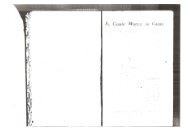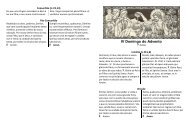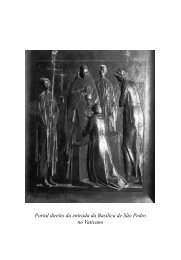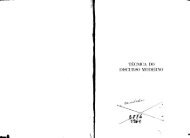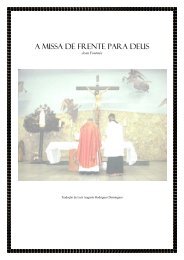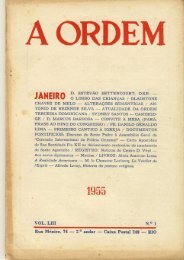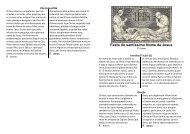- Page 2 and 3:
LIBRARY OF THE THEOLOGICAL SEMINARY
- Page 5 and 6:
HISTORY OF THE POPES VOL. XV
- Page 7 and 8:
o^^^ T H e \%^ HISTORY OF THE POP F
- Page 9:
CONTENTS OF VOLUME XV. Collections
- Page 12 and 13:
viii ARCHIVES AND MANUSCRIPTS IN VO
- Page 14 and 15:
X COMPLETE TITLES OF BOOKS Aumale,
- Page 16 and 17:
XU COMPLETE TITLES OF BOOKS Carcere
- Page 18 and 19:
xiv COMPLETE TITLES OF BOOKS Episto
- Page 20 and 21:
xvi COMPLETE TITLES OF BOOKS HUgers
- Page 22 and 23:
xviii COMPLETE TITLES OF BOOKS Lowe
- Page 24 and 25:
XX COMPLETE TITLES OF BOOKS Pieylin
- Page 26 and 27:
Xxii COMPLETE TITLES OF BOOKS Sdgmi
- Page 28 and 29:
XXIV COMPLETE TITLES OF BOOKS Verga
- Page 30 and 31:
XXVI TABLE OF CONTENTS. Non-observa
- Page 32 and 33:
XXVlll TABLE OF CONTENTS. A.D. ....
- Page 34 and 35:
XXX TABLE OF CONTENTS Complete conv
- Page 36 and 37:
XXxii TABLE OF CONTENTS. A.D. Offic
- Page 38 and 39:
XXXIV TABLE OF CONTENTS. :Morone ar
- Page 40 and 41:
LIST OF UNPUBLISHED DOCUMENTS IN AP
- Page 42 and 43:
XXXVlll AUTHOR S PREFACE. for the f
- Page 44 and 45:
Xl INTRODUCTION. diplomatic relatio
- Page 46 and 47:
Xlii INTRODUCTION. the more necessa
- Page 48 and 49:
Xliv INTRODUCTION. having been made
- Page 50 and 51:
xlvi INTRODUCTION. original documen
- Page 52 and 53:
XiVlll INTRODUCTION. led the Cathol
- Page 54 and 55:
2 HISTORY OF THE POPES. seemed to b
- Page 56 and 57:
4 HISTORY OF THE POPES. had given h
- Page 58 and 59:
6 HISTORY OF THE POPES. be followed
- Page 60 and 61:
8 HISTORY OF THE POPES. In his decr
- Page 62 and 63:
. 10 HISTORY OF THE POPES. France c
- Page 64 and 65:
12 HISTORY OF THE POPES. Duke Cosim
- Page 66 and 67:
^ 14 HISTORY OF THE POPES. Lenoncou
- Page 68 and 69:
l6 HISTORY OF THE POPES. once on th
- Page 70 and 71:
l8 HISTORY OF THE POPES. uncle, Pis
- Page 72 and 73:
20 HISTORY OF THE POPES. The Spania
- Page 74 and 75:
22 HISTORY OF THE POPES. du Bellay
- Page 76 and 77:
24 HISTORY OF THE POPES. Carafa, ho
- Page 78 and 79:
26 HISTORY OF THE POPES. made up hi
- Page 80 and 81:
28 lilSTORV OF THE POPES. Carpi and
- Page 82 and 83:
30 HISTORY OF THE POPES. von Thurm,
- Page 84 and 85:
32 HISTORY OF THE POPES. influence
- Page 86 and 87:
34 HISTORY OF THE POPES. Madruzzo,
- Page 88 and 89:
36 HISTORY OF THE POPES. to keep on
- Page 90 and 91:
.38 HISTORY OF THE POPES. on his be
- Page 92 and 93:
40 HISTORY OF THE POPES. Spanish pa
- Page 94 and 95:
42 HISTORY OF THE POPES. if they fl
- Page 96 and 97:
44 HISTORY OF THE POPES. city again
- Page 98 and 99:
46 HISTORY OF THE POPES. Farnese, o
- Page 100 and 101:
48 HISTORY OF THE POPES. The old op
- Page 102 and 103:
50 HISTORY OF THE POPES. Philip ; t
- Page 104 and 105:
52 HISTORY OF THE POPES. In the aft
- Page 106 and 107:
54 HISTORY OF THE POPES. ^ We posse
- Page 108 and 109:
56 HISTORY OF THE POPES. dition to
- Page 110 and 111:
58 HISTORY OF THE POPES. It was mor
- Page 112 and 113:
60 HISTORY OF THE POPES. concerning
- Page 114 and 115:
62 HISTORY OF THE POPES. and declar
- Page 116 and 117:
64 HISTORY OF THE POPES. of his sov
- Page 118 and 119:
CHAPTER II. Previous Life and Chara
- Page 120 and 121:
68 HISTORY OF THE POPES. family, Mo
- Page 122 and 123:
70 HISTORY OF THE POPES. Marquis of
- Page 124 and 125:
72 HISTORY OF THE POPES. Angelo, as
- Page 126 and 127:
74 HISTORY OF THE POPES. On his ret
- Page 128 and 129:
76 HISTORY OF THE POPES. had to pas
- Page 130 and 131:
78 HISTORY OF THE POPES. Emperor di
- Page 132 and 133:
80 HISTORY OF THE POPES. of his sho
- Page 134 and 135:
82 HISTORY OF THE POPES. for the at
- Page 136 and 137:
84 HISTORY OF THE POPES. for.i He w
- Page 138 and 139:
86 HISTORY OF THE POPES. Venetian a
- Page 140 and 141:
88 HISTORY OF THE POPES. were in no
- Page 142 and 143:
go HISTORY OF THE POPES. preferred
- Page 144 and 145:
92 HISTORY OF THE POPES. Pius IV. v
- Page 146 and 147:
CHAPTER III The Pope's Relatives. C
- Page 148 and 149:
96 HISTORY OF THE POPES. already me
- Page 150 and 151:
98 HISTORY OF THE POPES. very soon.
- Page 152 and 153:
100 HISTORY OF THE POPES. affection
- Page 154 and 155:
102 HISTORY OF THE POPES. Gabrio Se
- Page 156 and 157:
. 104 HISTORY OF THE POPES. Cardina
- Page 158 and 159:
I06 HISTORY OF THE POPES. had the e
- Page 160 and 161:
I08 HISTORY OF THE POPES. religious
- Page 162 and 163:
no HISTORY OF THE POPES. wrote on J
- Page 164 and 165:
112 HISTORY OF THE POPES. Cardinal
- Page 166 and 167:
114 HISTORY OF THE POPES. head fort
- Page 168 and 169:
Il6 HISTORY OF THE POPES. He bore i
- Page 170 and 171:
Il8 HISTORY OF THE POPES. his court
- Page 172 and 173:
120 HISTORY OF THE POPES. and in sp
- Page 174 and 175:
122 HISTORY OF THE POPES. little of
- Page 176 and 177:
124 HISTORY OF THE POPES. defection
- Page 178 and 179:
126 HISTORY OF THE POPES. from when
- Page 180 and 181:
128 HISTORY OF THE POPES. extraordi
- Page 182 and 183:
130 HISTORY OF THE POPES. city of t
- Page 184 and 185:
132 HISTORY OF THE POPES. capitulat
- Page 186 and 187:
134 HISTORY OF THE POPES. interests
- Page 188 and 189:
136 HISTORY OF THE POPES. Paul IV.,
- Page 190 and 191:
138 HISTORY OF THE POPES. although
- Page 192 and 193:
140 HISTORY OF THE POPES. In this s
- Page 194 and 195:
142 HISTORY OF THE POPES. with the
- Page 196 and 197:
144 HISTORY OF THE POPES. announced
- Page 198 and 199:
146 HISTORY OF THE POPES. their dis
- Page 200 and 201:
— 148 HISTORY OF THE POPES. of th
- Page 202 and 203:
150 HISTORY OF THE POPES, his disfa
- Page 204 and 205:
152 HISTORY OF THE POPES. which he
- Page 206 and 207:
154 HISTORY OF THE POPES, avail ; a
- Page 208 and 209:
156 HISTORY OF THE POPES. been gran
- Page 210 and 211:
158 HISTORY OF THE POPES. Tonina wa
- Page 212 and 213:
l60 HISTORY OF THE POPES. father, F
- Page 214 and 215:
l62 HISTORY OF THE POPES. justice w
- Page 216 and 217:
. 164 HISTORY OF THE POPES. ness an
- Page 218 and 219:
l66 HISTORY OF THE POPES. protectin
- Page 220 and 221:
l68 HISTORY OF THE POPES. salvation
- Page 222 and 223:
170 HISTORY OF THE POPES. he appear
- Page 224 and 225:
172 HISTORY OF THE POPES. on a litt
- Page 226 and 227:
174 HISTORY OF THE POPES. grief, on
- Page 228 and 229:
176 HISTORY OF THE POPES. as an onl
- Page 230 and 231:
178 HISTORY OF THE POPES. From this
- Page 232 and 233:
l80 HISTORY OF THE POPES. IV. had,
- Page 234 and 235:
l82 HISTORY OF THE POPES. first, by
- Page 236 and 237:
184 HISTORY OF THE POPES. in the di
- Page 238 and 239: l86 HISTORY OF THE POPES. but never
- Page 240 and 241: l88 HISTORY OF THE POPES. all in co
- Page 242 and 243: IQO HISTORY OF THE POPES. quite imp
- Page 244 and 245: 192 HISTORY OF THE POPES. several o
- Page 246 and 247: 194 HISTORY OF THE POPES. reported
- Page 248 and 249: 196 HISTORY OF THE POPES. and would
- Page 250 and 251: igS HISTORY OF THE POPES. it in han
- Page 252 and 253: 200 HISTORY OF THE POPES. ambassado
- Page 254 and 255: 202 HISTORY OF THE POPES. received
- Page 256 and 257: 204 HISTORY OF THE POPES. othei cit
- Page 258 and 259: 206 HISTORY OF THE POPES. and himse
- Page 260 and 261: 208 HISTORY OF THE POPES. it was of
- Page 262 and 263: 210 HISTORY OF THE POPES. of the Co
- Page 264 and 265: 212 HISTORY OF THE POPES. This jubi
- Page 266 and 267: 214 HISTORY OF THE POPES. cal and g
- Page 268 and 269: CHAPTER VI. The Mission of Commendo
- Page 270 and 271: 2l8 HISTORY OF THE POPES. the bull
- Page 272 and 273: 220 HISTORY OF THE POPES. On Januar
- Page 274 and 275: 222 HISTORY OF THE POPES. Ferdinand
- Page 276 and 277: 224 HISTORY OF THE POPES. amplified
- Page 278 and 279: 226 HISTORY OF THE POPES. Commendon
- Page 280 and 281: 228 HISTORY OF THE POPES. had still
- Page 282 and 283: 230 HISTORY OF THE POPES. with grea
- Page 284 and 285: 232 HISTORY OF THE POPES. no time i
- Page 286 and 287: 234 HISTORY OF THE POPES. his stay
- Page 290 and 291: 238 HISTORY OF THE POPES. Munich Co
- Page 292 and 293: 240 HISTORY OF THE POPES. on June 4
- Page 294 and 295: 242 HISTORY OF THE POPES. therefore
- Page 296 and 297: 244 HISTORY OF THE POPES. on March
- Page 298 and 299: 246 HISTORY OF THE POPES. ^ the ref
- Page 300 and 301: 248 HISTORY OF THE POPES. On March
- Page 302 and 303: 250 HISTORY OF THE POPES. tions.^ H
- Page 304 and 305: 252 HISTORY OF THE POPES. On April
- Page 306 and 307: ^ 254 HISTORY OF THE POPES. Pope co
- Page 308 and 309: 256 HISTORY OF THE POPES. had decid
- Page 310 and 311: 258 HISTORY OF THE POPES. announced
- Page 312 and 313: 26o HISTORY OF THE POPES. of contin
- Page 314 and 315: 262 HISTORY OF THE POPES. busily em
- Page 316 and 317: CHAPTER VIII. Reopening of the Coun
- Page 318 and 319: 2 66 HISTORY OF THE POPES. debated
- Page 320 and 321: 268 HISTORY OF THE POPES. bishop of
- Page 322 and 323: 270 HISTORY OF THE POPES. be given
- Page 324 and 325: 272 HISTORY OF THE POPES. It then h
- Page 326 and 327: 274 HISTORY OF THE POPES. The Bened
- Page 328 and 329: 276 HISTORY OF THE POPES. the legat
- Page 330 and 331: 278 HISTORY OF THE POPES. current o
- Page 332 and 333: 28o HISTORY OF THE POPES. which cam
- Page 334 and 335: 282 HISTORY OF THE POPES. belong, h
- Page 336 and 337: 284 HISTORY OF THE POPES. After the
- Page 338 and 339:
286 HISTORY OF THE POPES. During th
- Page 340 and 341:
288 HISTORY OF THE POPES. ^ aims of
- Page 342 and 343:
290 HISTORY OF THE POPES. legates,
- Page 344 and 345:
292 HISTORY OF THE POPES. to obtain
- Page 346 and 347:
294 HISTORY OF THE POPES. Visconti
- Page 348 and 349:
296 HISTORY OF THE POPES. It was re
- Page 350 and 351:
298 HISTORY OF THE POPES. sacrifice
- Page 352 and 353:
300 HISTORY OF THE POPES. same time
- Page 354 and 355:
302 HISTORY OF THE POPES. others al
- Page 356 and 357:
304 HISTORY OF THE POPES. the legat
- Page 358 and 359:
306 HISTORY OF THE POPES. commissio
- Page 360 and 361:
308 HISTORY OF THE POPES. against t
- Page 362 and 363:
310 HISTORY OF THE POPES. the Emper
- Page 364 and 365:
312 HISTORY OF THE POPES. In the me
- Page 366 and 367:
314 HISTORY OF THE POPES. peror ; o
- Page 368 and 369:
3l6 HISTORY OF THE POPES. which was
- Page 370 and 371:
3l8 HISTORY OF THE POPES. pension,
- Page 372 and 373:
320 HISTORY OF THE POPES. sentiment
- Page 374 and 375:
322 HISTORY OF THE POPES. him, and
- Page 376 and 377:
324 HISTORY OF THE POPES. demand fo
- Page 378 and 379:
326 HISTORY OF THE POPES. should re
- Page 380 and 381:
2 ^ CHAPTER X. The Concluding Sessi
- Page 382 and 383:
330 HISTORY OF THE POPES. in German
- Page 384 and 385:
332 HISTORY OF THE POPES. on June 8
- Page 386 and 387:
334 HISTORY OF THE POPES. mine the
- Page 388 and 389:
336 HISTORY OF THE POPES. extreme t
- Page 390 and 391:
338 HISTORY OF THE POPES. chapters
- Page 392 and 393:
340 HISTORY OF THE POPES. general r
- Page 394 and 395:
' dom 342 HISTORY OF THE POPES. por
- Page 396 and 397:
344 HISTORY OF THE POPES. legates w
- Page 398 and 399:
346 HISTORY OF THE POPES. but that
- Page 400 and 401:
34^ HISTORY OF THE POPES. desired b
- Page 402 and 403:
350 HISTORY OF THE POPES. Morone, w
- Page 404 and 405:
352 HISTORY OF THE POPES. why Pius
- Page 406 and 407:
354 HISTORY OF THE POPES. when pass
- Page 408 and 409:
356 HISTORY OF THE POPES. violently
- Page 410 and 411:
358 HISTORY OF THE POPES. bestowal
- Page 412 and 413:
360 HISTORY OF THE POPES. were subm
- Page 414 and 415:
362 HISTORY OF THE POPES. of the gr
- Page 416 and 417:
364 HISTORY OF THE POPES. in peace
- Page 418 and 419:
CHAPTER XI Significance of the Coun
- Page 420 and 421:
368 HISTORY OF THE POPES. that the
- Page 422 and 423:
370 HISTORY OF THE POPES. that the
- Page 424 and 425:
372 HISTORY OF THE POPES. The abuse
- Page 426 and 427:
^ 374 HISTORY OF THE POPES. his pow
- Page 428 and 429:
376 HISTORY OF THE POPES. as possib
- Page 430 and 431:
37^ HISTORY OF THE POPES. however,
- Page 433 and 434:
APPENDIX, PRELIMINARY NOTICE. The f
- Page 435 and 436:
APPENDIX. 383 Monte, Madruzzo, Savc
- Page 437 and 438:
APPENDIX. 385 Crispi 13 ; Cr. del M
- Page 439 and 440:
APPENDIX. 387 57. (Tuesday, 28 Nov.
- Page 441 and 442:
APPENDIX. 389
- Page 443 and 444:
APPENDIX. 391 report, and penetrate
- Page 445 and 446:
APPENDIX. 393 per haver qualche chi
- Page 447 and 448:
APPENDIX. 395 molt' allegramentc ;
- Page 449 and 450:
APPENDIX. 397 militie S*^' Michaeli
- Page 451 and 452:
APPENDIX. 399 orbis et Ecclesie sca
- Page 453 and 454:
APPENDIX. 401 Presentetur. B. Ameri
- Page 455 and 456:
APPENDIX. 403 13. Consistory of 3 M
- Page 457 and 458:
APPENDIX. 405 tutti e tre fuori di
- Page 459 and 460:
APPENDIX. 407 vedera con qiiesta al
- Page 461 and 462:
APPENDIX. 409 egli facesse il quart
- Page 463 and 464:
APPENDIX. 411 mente ; et Sua S^^ 1'
- Page 465 and 466:
APPENDIX. 413 di Penitentiaria et d
- Page 467 and 468:
APPENDIX. 415 ponti che non sono an
- Page 469 and 470:
APPENDIX. 417 by word of mouth, a j
- Page 471 and 472:
APPENDIX. 419 considerat, liberalit
- Page 473 and 474:
APPENDIX. 421 indictio of the Counc
- Page 475 and 476:
APP'ENDIX. 423 Mo substantial chang
- Page 477 and 478:
attonito et quorsum isthaec tendere
- Page 479 and 480:
APPENDIX. 427 Inter multas praecipa
- Page 481:
APPENDIX. 429 lum praebere : et ant
- Page 484 and 485:
432 INDEX OF NAMES. Boncompagni, Ug
- Page 486 and 487:
434 Corgna, Ascanio della (nephew o
- Page 488 and 489:
436 INDEX OF NAMES. Grimani, Giovan
- Page 490 and 491:
438 Medici, Chiara de' (sister of P
- Page 492 and 493:
440 Ricci, Cardinal, 6 n. 5, 14, 24
- Page 494:
44^ Violante d'Alife, see Alife. Vi




